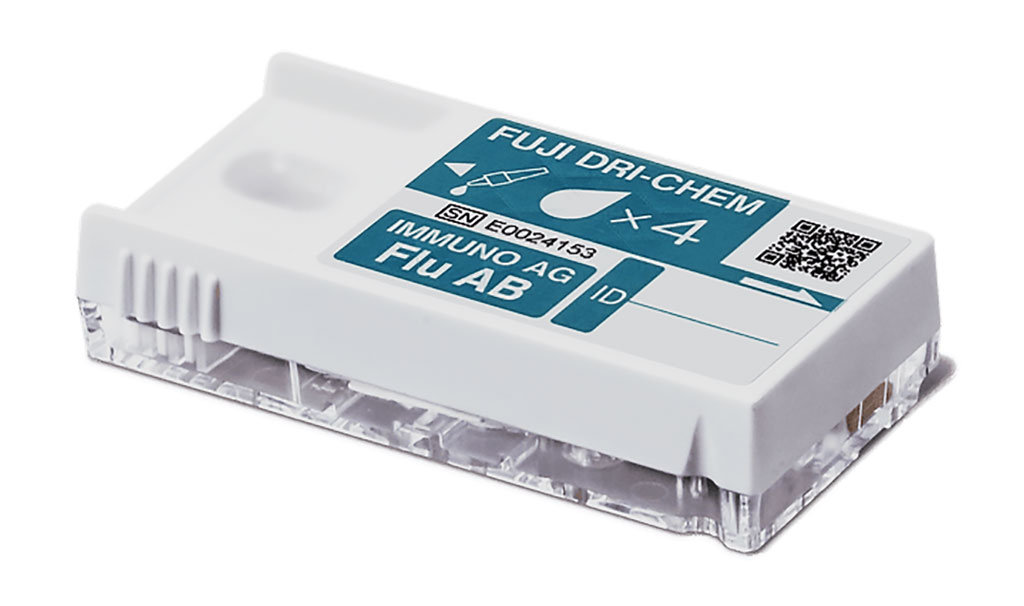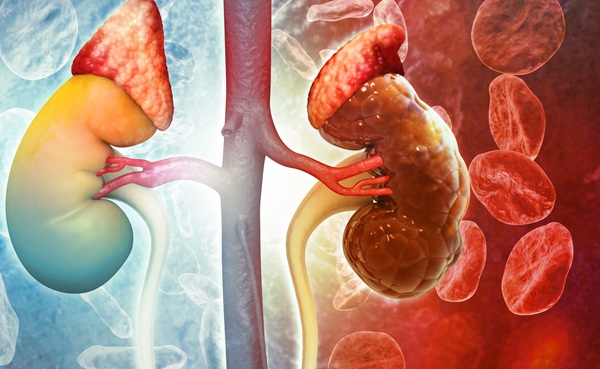High Performance of Rapid Influenza Diagnostic Test Validated
|
By LabMedica International staff writers Posted on 19 Dec 2019 |

Image: The Fuji dri-chem immuno AG cartridge FluAB kit (Photo courtesy of Fujifilm Corporation)
Influenza is a leading infectious cause of morbidity and mortality worldwide. Annually, about 5% to 10% of adults and 20% to 30% of children have symptoms of influenza-like illness (ILI), and approximately 650,000 deaths secondary to influenza occur each epidemic season.
Timely diagnosis and early antiviral therapy are crucial to counteract influenza spread. However, current diagnostic tools such as the real-time polymerase chain reaction (RT-PCR) are expensive and time-consuming. Some rapid influenza diagnostic tests (RIDTs) are also used to rapidly support treatment decision during influenza outbreaks. Nonetheless, RIDTs’ performance varies according to the prevalence of different influenza virus strains and the method used to determine their results.
A large group of scientists working with the National Institute of Respiratory Diseases (INER, Mexico City, Mexico) enrolled in their study 592 participants, 45.6% males and 54.3% females; their median age was 14 years. From these, 171 subjects (28.9%) received influenza vaccination for the evaluated season: 127 were immunized with the IIV3 and 44 received the IIV4. They enrolled the patients attending to the INER from October 2016 to March 2017.
The team used the Fuji dri-chem immuno AG cartridge FluAB kit (Fujifilm Corporation, Tokyo, Japan) for detection of influenza viruses in fresh respiratory specimens. This test utilizes the immunochromatographic principle of virus detection as other conventional rapid influenza diagnostic tests (RIDTs), adding the silver amplification principle of photographic development to improve its sensitivity. Detection of influenza viruses was assessed by RT-PCR and nucleic acid extraction from the clinical samples was performed with the PureLink Viral RNA/DNA mini kit (Thermo Fisher Scientific, Inc, Waltham MA, USA). The amplification was accomplished using the CFX96 Real Time System Bio-Rad Platform (Bio-Rad Laboratories Inc, Hercules, CA, USA).
The investigators reported that of the enrolled 592 patients. RT-PCR detected 93 cases of influenza A(H1N1)pdm09, 55 of AH3N2, 141 of B, and 13 A/B virus infections. RIDT showed 90.7% sensitivity and 95.7% specificity for influenza A virus detection, and 91.5% sensitivity and 95.3% specificity for influenza B virus detection. Overall vaccines’ effectiveness (VE) was 33.2% against any laboratory-confirmed influenza infection. VE estimates against influenza B were higher for the quadrivalent vaccine. Immunization and occupational exposure were protective factors against influenza.
The authors concluded that the RIDT was useful to detect influenza cases during an outbreak setting. Effectiveness of 2016/17 influenza vaccines administered in Mexico was low, but significant. The study was published in the December, 2019 issue of the International Journal of Infectious Diseases.
Related Links:
National Institute of Respiratory Diseases
Fujifilm Corporation
Thermo Fisher Scientific
Bio-Rad Laboratories
Timely diagnosis and early antiviral therapy are crucial to counteract influenza spread. However, current diagnostic tools such as the real-time polymerase chain reaction (RT-PCR) are expensive and time-consuming. Some rapid influenza diagnostic tests (RIDTs) are also used to rapidly support treatment decision during influenza outbreaks. Nonetheless, RIDTs’ performance varies according to the prevalence of different influenza virus strains and the method used to determine their results.
A large group of scientists working with the National Institute of Respiratory Diseases (INER, Mexico City, Mexico) enrolled in their study 592 participants, 45.6% males and 54.3% females; their median age was 14 years. From these, 171 subjects (28.9%) received influenza vaccination for the evaluated season: 127 were immunized with the IIV3 and 44 received the IIV4. They enrolled the patients attending to the INER from October 2016 to March 2017.
The team used the Fuji dri-chem immuno AG cartridge FluAB kit (Fujifilm Corporation, Tokyo, Japan) for detection of influenza viruses in fresh respiratory specimens. This test utilizes the immunochromatographic principle of virus detection as other conventional rapid influenza diagnostic tests (RIDTs), adding the silver amplification principle of photographic development to improve its sensitivity. Detection of influenza viruses was assessed by RT-PCR and nucleic acid extraction from the clinical samples was performed with the PureLink Viral RNA/DNA mini kit (Thermo Fisher Scientific, Inc, Waltham MA, USA). The amplification was accomplished using the CFX96 Real Time System Bio-Rad Platform (Bio-Rad Laboratories Inc, Hercules, CA, USA).
The investigators reported that of the enrolled 592 patients. RT-PCR detected 93 cases of influenza A(H1N1)pdm09, 55 of AH3N2, 141 of B, and 13 A/B virus infections. RIDT showed 90.7% sensitivity and 95.7% specificity for influenza A virus detection, and 91.5% sensitivity and 95.3% specificity for influenza B virus detection. Overall vaccines’ effectiveness (VE) was 33.2% against any laboratory-confirmed influenza infection. VE estimates against influenza B were higher for the quadrivalent vaccine. Immunization and occupational exposure were protective factors against influenza.
The authors concluded that the RIDT was useful to detect influenza cases during an outbreak setting. Effectiveness of 2016/17 influenza vaccines administered in Mexico was low, but significant. The study was published in the December, 2019 issue of the International Journal of Infectious Diseases.
Related Links:
National Institute of Respiratory Diseases
Fujifilm Corporation
Thermo Fisher Scientific
Bio-Rad Laboratories
Latest Microbiology News
- Blood-Based Diagnostic Method Could Identify Pediatric LRTIs
- Rapid Diagnostic Test Matches Gold Standard for Sepsis Detection
- Rapid POC Tuberculosis Test Provides Results Within 15 Minutes
- Rapid Assay Identifies Bloodstream Infection Pathogens Directly from Patient Samples
- Blood-Based Molecular Signatures to Enable Rapid EPTB Diagnosis
- 15-Minute Blood Test Diagnoses Life-Threatening Infections in Children
- High-Throughput Enteric Panels Detect Multiple GI Bacterial Infections from Single Stool Swab Sample
- Fast Noninvasive Bedside Test Uses Sugar Fingerprint to Detect Fungal Infections
- Rapid Sepsis Diagnostic Device to Enable Personalized Critical Care for ICU Patients
- Microfluidic Platform Assesses Neutrophil Function in Sepsis Patients
- New Diagnostic Method Confirms Sepsis Infections Earlier
- New Markers Could Predict Risk of Severe Chlamydia Infection
- Portable Spectroscopy Rapidly and Noninvasively Detects Bacterial Species in Vaginal Fluid
- CRISPR-Based Saliva Test Detects Tuberculosis Directly from Sputum
- Urine-Based Assay Diagnoses Common Lung Infection in Immunocompromised People
- Saliva Test Detects Implant-Related Microbial Risks
Channels
Clinical Chemistry
view channel
POC Breath Diagnostic System to Detect Pneumonia-Causing Pathogens
Pseudomonas aeruginosa is a major cause of hospital-acquired and ventilator-associated pneumonia, particularly in lung transplant recipients and patients with structural lung disease. Its ability to form... Read more
Online Tool Detects Drug Exposure Directly from Patient Samples
Doctors often rely on patient interviews and medical records to determine what medications a person has taken, but this information is frequently incomplete. People may forget drugs they used, take over-the-counter... Read moreMolecular Diagnostics
view channel
Blood Biomarker Improves Early Brain Injury Prognosis After Cardiac Arrest
After a cardiac arrest, many patients remain unconscious for days, leaving doctors and families facing uncertainty about whether meaningful recovery is possible. Current tools to assess brain damage, including... Read more
Biomarkers Could Identify Patients at High Risk of Severe AKI After Major Surgery
Acute kidney injury is one of the most common and dangerous complications after major surgery, particularly among patients in intensive care. Even mild impairment of kidney function can lead to long-term... Read more
CLIA Test Identifies Head and Neck Cancer Recurrence from Post-Surgical Lymphatic Fluid
While the lymphatic system’s critical role in metastasis has long been recognized, routine access to patient lymph has been elusive. Now, a non-invasive process can access lymph through the collection... Read moreHematology
view channel
MRD Tests Could Predict Survival in Leukemia Patients
Acute myeloid leukemia is an aggressive blood cancer that disrupts normal blood cell production and often relapses even after intensive treatment. Clinicians currently lack early, reliable markers to predict... Read more
Platelet Activity Blood Test in Middle Age Could Identify Early Alzheimer’s Risk
Early detection of Alzheimer’s disease remains one of the biggest unmet needs in neurology, particularly because the biological changes underlying the disorder begin decades before memory symptoms appear.... Read more
Microvesicles Measurement Could Detect Vascular Injury in Sickle Cell Disease Patients
Assessing disease severity in sickle cell disease (SCD) remains challenging, especially when trying to predict hemolysis, vascular injury, and risk of complications such as vaso-occlusive crises.... Read more
ADLM’s New Coagulation Testing Guidance to Improve Care for Patients on Blood Thinners
Direct oral anticoagulants (DOACs) are one of the most common types of blood thinners. Patients take them to prevent a host of complications that could arise from blood clotting, including stroke, deep... Read moreImmunology
view channelBlood Test Could Detect Adverse Immunotherapy Effects
Immune checkpoint inhibitors have transformed cancer treatment, but they can also trigger serious immune-related adverse events that damage healthy organs and may become life-threatening if not detected early.... Read more
Routine Blood Test Can Predict Who Benefits Most from CAR T-Cell Therapy
CAR T-cell therapy has transformed treatment for patients with relapsed or treatment-resistant non-Hodgkin lymphoma, but many patients eventually relapse despite an initial response. Clinicians currently... Read morePathology
view channel
Rapid Low-Cost Tests Can Prevent Child Deaths from Contaminated Medicinal Syrups
Medicinal syrups contaminated with toxic chemicals have caused the deaths of hundreds of children worldwide, exposing a critical gap in how these products are tested before reaching patients.... Read more
Tumor Signals in Saliva and Blood Enable Non-Invasive Monitoring of Head and Neck Cancer
Head and neck cancers are among the most aggressive malignancies worldwide, with nearly 900,000 new cases diagnosed each year. Monitoring these cancers for recurrence or relapse typically relies on tissue... Read more
Common Health Issues Can Influence New Blood Tests for Alzheimer’s Disease
Blood-based tests for Alzheimer’s disease are transforming diagnosis by offering a simpler alternative to spinal taps and brain imaging. However, many people evaluated at memory clinics also live with... Read more
Blood Test Formula Identifies Chronic Liver Disease Patients with Higher Cancer Risk
Chronic liver disease affects millions worldwide and can progress silently to hepatocellular carcinoma (HCC), one of the deadliest cancers globally. While surveillance guidelines exist for patients with... Read moreTechnology
view channel
Machine Learning Models Diagnose ALS Earlier Through Blood Biomarkers
Amyotrophic lateral sclerosis (ALS) is a rapidly progressive neurodegenerative disease that is notoriously difficult to diagnose in its early stages. Early symptoms often overlap with other neurological... Read more
Artificial Intelligence Model Could Accelerate Rare Disease Diagnosis
Identifying which genetic variants actually cause disease remains one of the biggest challenges in genomic medicine. Each person carries tens of thousands of DNA changes, yet only a few meaningfully alter... Read moreIndustry
view channel
BD and Penn Institute Collaborate to Advance Immunotherapy through Flow Cytometry
BD (Becton, Dickinson and Company, Franklin Lakes, NJ, USA) has entered into a strategic collaboration with the Institute for Immunology and Immune Health (I3H, Philadelphia, PA, USA) at the University... Read more









 assay.jpg)










